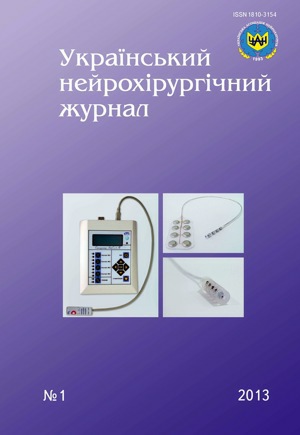Radiography and complex ultrasound scanning: optimal screening methods in diagnosis of vertebrogenic changes in vertebral arteries at cerebrovascular blood flow disorders
DOI:
https://doi.org/10.25305/unj.55542Keywords:
vertebrogenic changes of vertebral arteries, cerebrovascular circulation disorder, posterior basin, stenosis, ultrasound scanningAbstract
Introduction. Number of causes of cerebral vascular pathology justifies the necessity for a balanced application of modern instrumental complex in patients with cerebral blood flow disorders. However, more frequently practitioners exclude radiography and complex ultrasound scanning – methods of primary screening of high informativity, and begin the study with expensive methods such as MRI and SCT.
Methods. The results of complex survey of 103 patients with ischemic circulation disorders in posterior basin due to vertebrogenic stenosis of vertebral artery were analyzed. We studied the results of cervical radiography and complex ultrasound scanning in the diagnosis of blood flow pathology.
Results. According to data of radiography of cervical spine we found no difference between clinical diagnosis and results of radiography. Complex ultrasound scanning of vessels of cervical spine showed its high informativity in diagnosis of extravasal compression of vertebral artery, which allowed us not only to define the strategy of further diagnosis with additional neurovizualizing techniques, but also to treat stenosis of vertebral artery.
Conclusions. Radiography and complex ultrasound scanning is the optimal method of high informativity for screening of vertebrogenic changes of vertebral arteries, cerebrovascular blood flow disorders. The data obtained, allowed us to define precise indications for MRI, SCT scanning, provided proper information for further treatment.
References
1. Barykova T, Fastakovskaya E.[Vestibular vertigo in emergency neurology and cervical osteochondrosis]. Neurology, neuropsychiatry, Psychosomatics. 2010;0(2):55. Russian. [CrossRef]
2. Panteleeva EA. [The vertebral artery syndrome and patient management tactics]. Zh Nevrol Psikhiatr Im S S Korsakova. 2012;112(12):46-50. Russian. [PubMed]
3. Skrylev SI, Shchipakin VL, Koshcheyev F. [et al.]. Sovremennyye vozmozhnosti khirurgicheskogo lecheniya mnozhestvennykh porazheniy brakhiotsefalnykh arteriy. Annaly klin. i eksperim. nevrologii. 2009;3(2):43-48. Russian.
4. Burak GG, Samsonova IV. Anomalii stroyeniya i topografii pozvonochnykh arteriy: anatomo-klinicheskiye aspekty. Vestn. Viteb. gos. med. un–ta. 2008;7(1):39-45. Russian.
5. Sitel AB, Nefedov A YU, Lesovoy VO. Kompleksnaya diagnostika sindroma pozvonochnoy arterii. Zhurn. nevrologii i psikhiatrii im. S.S. Korsakova. Spetsvyp. «Neyrodiagnostika»; 2003. Russian.
6. Odinak MM, Mikhaylenko AA, Ivanov YUS, Semin GF. Sosudistyye zabolevaniya golovnogo mozga [Vascular diseases of the brain]. Sankt-Peterburg: Gippokrat; 2003. Russian.
7. Uchino A, Saito N, Okada Y et al. Fenestrations of the intracranial vertebrobasilar system diagnosed by MR angiography. Neuroradiology. 2011;54(5):445-450. [CrossRef] [PubMed]
8. Metelkina LP, Vereshchagin HB. Sovremennyye aspekty diagnostiki anomalii i deformatsii pozvonochnoy arterii.[ Modern aspects concerning diagnostics of the anomalies and malformations of the vertebral artery]. Neyrokhirurgiya. 2005;4:7-12. Russian. [eLIBRARY.ru].
9. Losev R Z, Nikolenko VN, Sholomov II, Khachatryan AM. Diagnostika i lecheniye bolnykh s nedostatochnostyu krovoobrashcheniya v vertebralno-bazilyarnom basseyne. Sarat. nauch.–med. zhurn. 2009; 5(4):629-634. Russian.
Downloads
Published
How to Cite
Issue
Section
License
Copyright (c) 2013 Konstantin Zozulya, Leonid Yakovenko

This work is licensed under a Creative Commons Attribution 4.0 International License.
Ukrainian Neurosurgical Journal abides by the CREATIVE COMMONS copyright rights and permissions for open access journals.
Authors, who are published in this Journal, agree to the following conditions:
1. The authors reserve the right to authorship of the work and pass the first publication right of this work to the Journal under the terms of Creative Commons Attribution License, which allows others to freely distribute the published research with the obligatory reference to the authors of the original work and the first publication of the work in this Journal.
2. The authors have the right to conclude separate supplement agreements that relate to non-exclusive work distribution in the form of which it has been published by the Journal (for example, to upload the work to the online storage of the Journal or publish it as part of a monograph), provided that the reference to the first publication of the work in this Journal is included.









